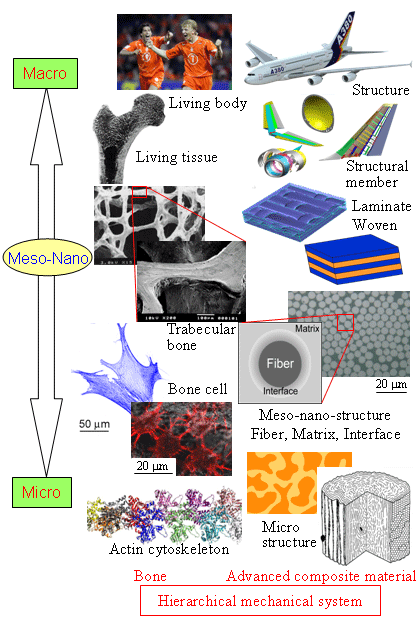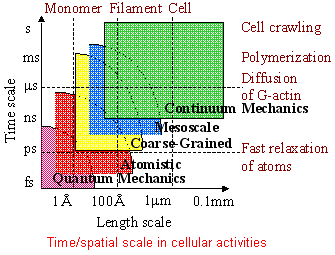Japanese English
yCreation of Novel Materials/Structures and Functions by Nano-bio-fusion Technologiesz
@We study on self-diagnosis, self-healing and environmental adaptation functions of living tissue/cells, and on evaluation and optimum control methods of meso- and nano- structures in advanced composite materials. We are also basically investigating novel high-performance materials/structures, which are environment-friendly and smart, with aid of meso- and nano- advanced technologies. Furthermore, we are challenging to develop nano-bio-fusion-systems using cells and artificial molecular structures. We focus on complex hierarchical mechanical system common to living tissue/cells and advanced composite materials, and aim to fuse novel bio- and nano- technologies from viewpoint of multi-scale mechanics.yMulti-scale Mechanicsz@In bone as ultimate smart material, environmental-adaptive trabecular
structures are formed by remodeling induced by microscopic activities of
bone cells (osteoclasts, osteoblasts and osteocytes) via actin cytoskeleton.
Then, bone macroscopically performs its functions as group of trabecula.
On the other hand, mesoscopic structures decide macroscopic properties
in advanced composite materials, which are applied for advanced fields
such as aerospace field, magnetic levitation vehicles, energy field and
bio-field. These mesoscopic structures are microscopically group of molecules
and atoms.
|
 |
yBiomechanics in Adaptation of Living Tissue and Cellz
@Living tissue and cell are known to adapt to surrounding environment functionally by remodeling. We aim to create novel structure and material, studying such a self-diagnosis, self-healing and environmental adaptation functions. We are also challenging to develop methods to evaluate cellular properties on deformation and response under microscopes, in order to clarify cellular responding properties to mechanical stimulation microscopically. We aim to understand complex behavior as living system and ingenious mechanism produced by interaction between hierarchical structures from viewpoint of biomechanics, and to propose ideas and techniques for novel harmony and fusion of living bodies and artificial materials. |

yComputational Mechanics on Molecular Structure Dynamicsz
@The deformation/fracture properties of advanced composite materials are governed by not only carbon fiber, carrying their high-performance mechanical properties, but also behaviors of resin (polymer) and fiber/resin-interface, carrying mechanical transmission between fibers. Mechanical properties of polymer materials are decided by two main factors; elasticity and visco-elasticity. In order to clarify these behavior physically, it is necessary to investigate meso-scale molecular structural dynamics where molecular structure is coarse-grained suitably. Actin cytoskeleton has complex and various cellular functions. In these molecular structures, mechanical hierarchy is existing. Here, functions of composite materials and cells are achieved by change in molecular structures, and accompanying change in surrounding mechanical environment induces change in molecular structures. Through description of meso-nano-scopic molecular structure dynamics, we challenge to understand mechanism of complex and skillful behavior in composite materials and cells, and to merge cell and artificial molecular structure. |
 |
yCreation of Self-assembly Nano Structure/System by Nano-bio-fusion Technologyz
@DesOxyribonucleic Acid (DNA), which is blueprint of life, has nano-sized double-helix-structure, which has complementary hydrogen bonds between adenine (A) and thymine (T), and guanine (G) and cytosine (C), respectively. Thus, single-strand DNA can be considered as components to assemble nano-sized structure/function automatically using spontaneous bond with its complemental strand. On the other hand, phospholipid can be considered as pseudo cell membrane because it forms closed vesicle with size of sub-micron to micron spontaneously in solution. Thus, phospholipid can be applied as reactor to artificially regulate expression of intracellular protein molecular structure. We are challenging to create novel self-assembly structure/system by fusion of nano- and bio- technologies. |
yStrength/Function Regulating Mechanism in High-performance Advanced Compostie Materials with Controlled Meso-nano-structurez
@Superconductors applied to magnetic levitation vehicles etc. are functional advanced composite materials composed of superconducting films or filaments. However, they have problem on damage of superconductor at small strain level. CFRPs (Carbon Fiber-Reinforced Plastics) are widely applied to advanced fields such as aero-space field due to their lightness and excellent strength and modulus. Recently, high performance materials with controlled nano-meso sturucture (nm?mm), such as fiber, matrix and interface, are reallized. HAp/PLLA composite material, composed of biodegradable polymer (Poly L-Lactic Acid: PLLA) and main component of bone (Hydroxy Apatite: HAp), is expected to be applied to tissue engineering for functional substitution of bone defects and bone regeneration. We are investigating complex strength/function regulating mechanisms in advanced composite materials experimentally and analytically from viewpoint of mechanics on interaction between macro- and micro- hierarchies, and contribute to feedback to material design and manufacturing, improvement in safety and reliability, and improvement in energy efficiency. We are challenging to develop quantitative evaluation technique of meso-nano-scale mechanical properties, such as quantitative evaluation of interfacial fracture, in order to design optimized meso-nano-strucure theoretically. |

